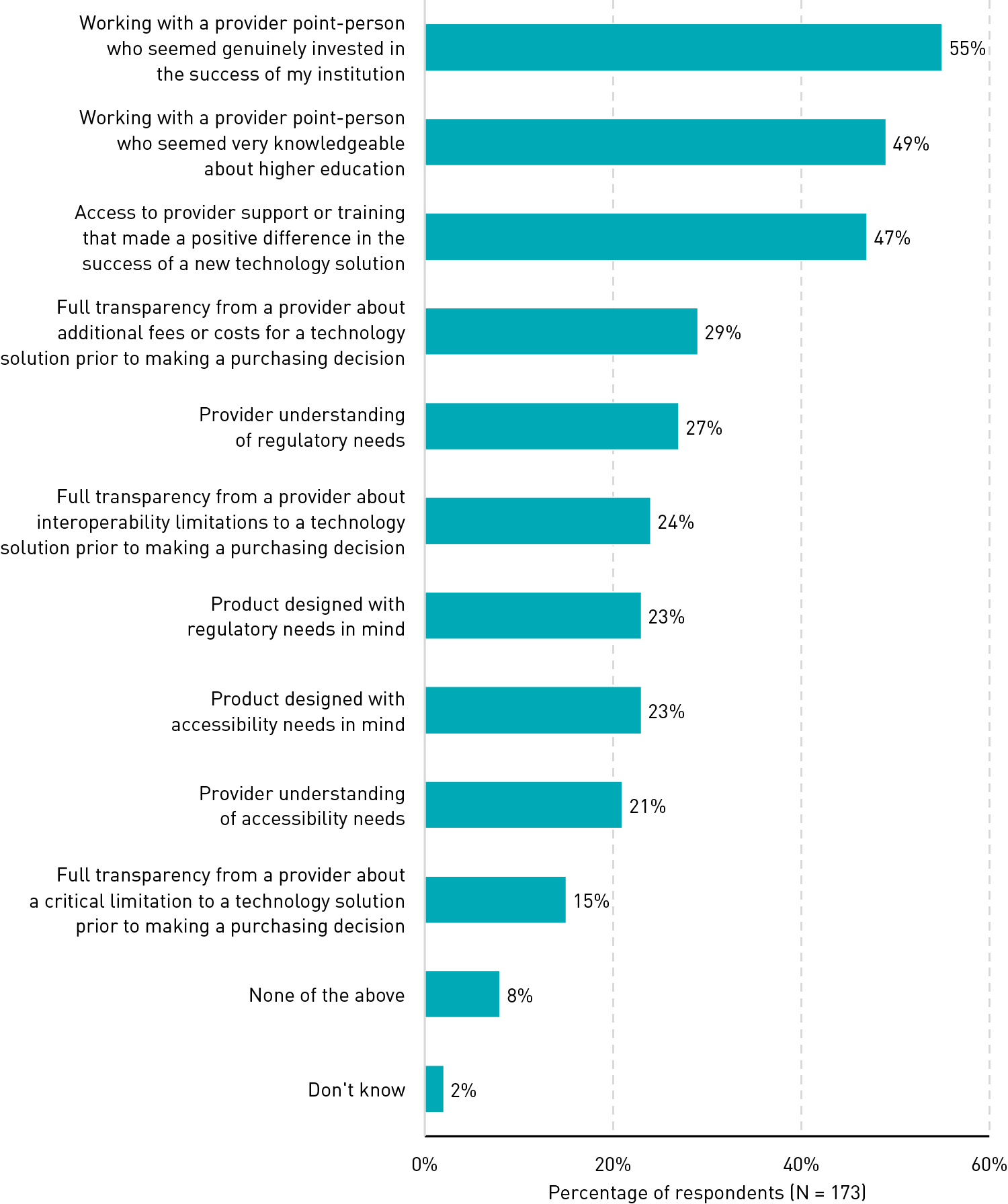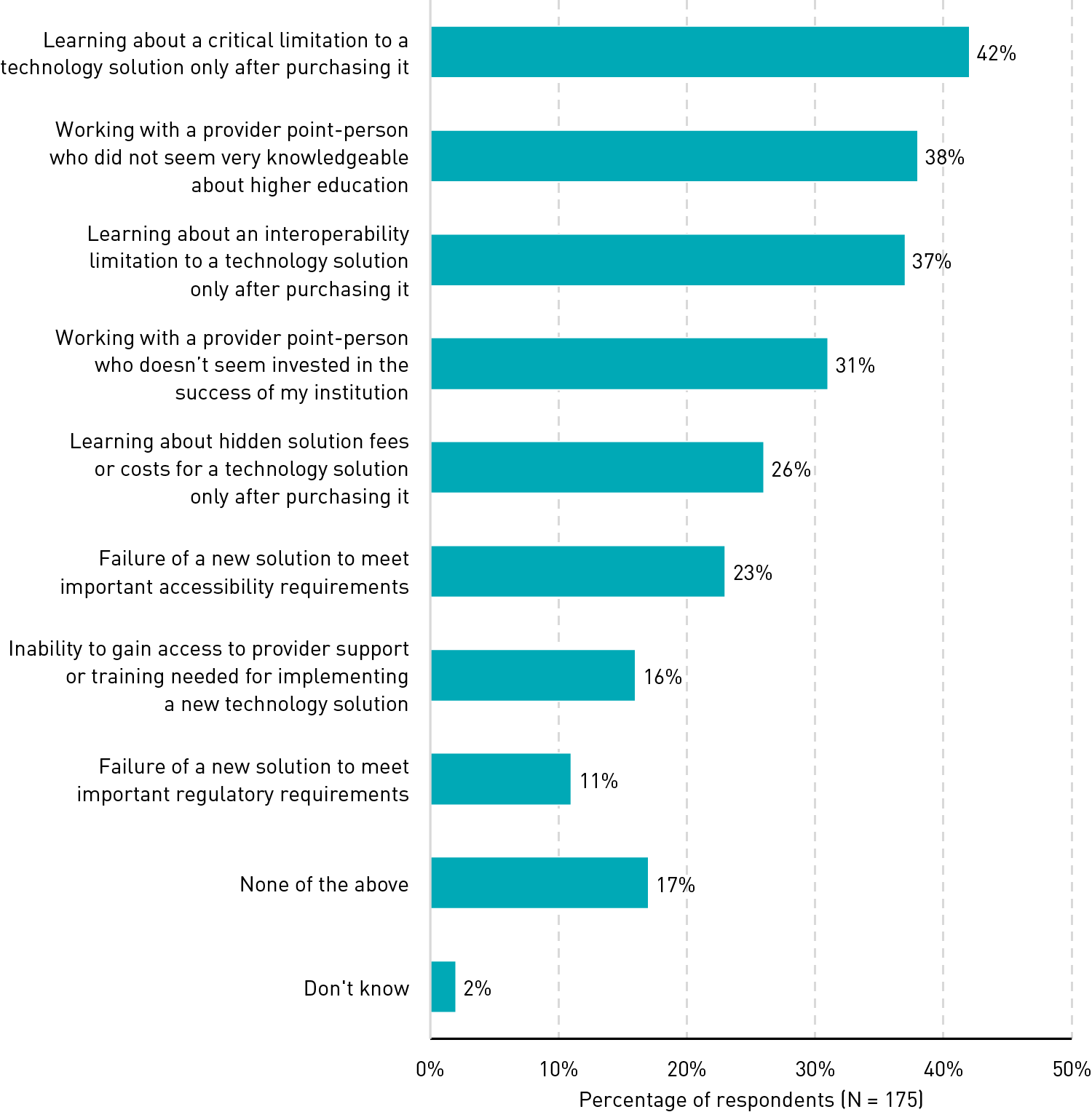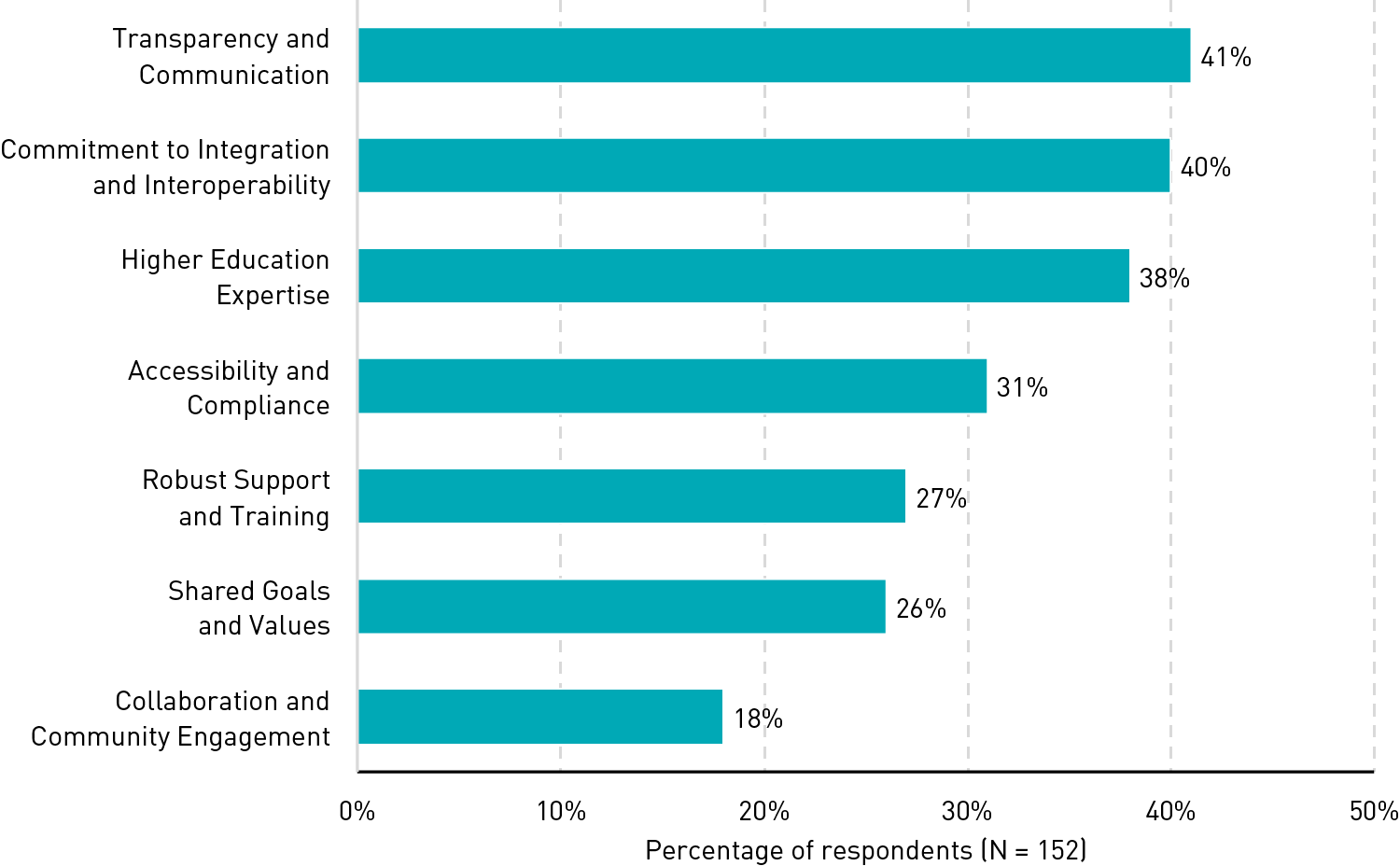Collaborative partnerships between higher education institutions and technology solution providers are strengthened by focusing on great communication, shared vision, and top-notch expertise.

EDUCAUSE is helping institutional leaders, IT professionals, and other staff address their pressing challenges by sharing existing data and gathering new data from the higher education community. This report is based on an EDUCAUSE QuickPoll. QuickPolls enable us to rapidly gather, analyze, and share input from our community about specific emerging topics.Footnote1
The Challenge
Working with technology solution providers is an important part of managing technology at colleges and universities. As institutions increasingly rely on third parties to meet their technology needs, solution providers will become an even more critical part of the higher education ecosystem, driving technological advancement, enhancing operational efficiency, and supporting the digital transformation of higher education. Institutional representatives want industry partners they can trust—partners who understand and care about the mission of higher education and can work collaboratively to solve institutions' stickiest problems. This QuickPoll surveyed institutional representatives involved in managing relationships with technology service providers on behalf of their institution. Solution providers and institutional representatives can use these findings to facilitate more effective approaches to partnerships.
The Bottom Line
Though a majority (63%) of QuickPoll respondents said they are satisfied or very satisfied with the technology solution provider relationships they've established within the past year, work remains to be done. For example, just 36% of respondents said that in most cases they feel very confident that a technology solution decision they're about to make for their institution is the right and best decision. Common pain points include learning about a critical limitation or interoperability limitation to a technology solution only after purchasing it and working with a provider point-person who is not knowledgeable about higher education or invested in the success of the institution. These findings point to clear opportunities for solution providers to improve services and forge stronger partnerships with institutions by focusing on communication, vision, and expertise.
The Data: Creating Good Partnerships
Everything matters. QuickPoll respondents ranked the qualities they consider when vetting and selecting a technology solution provider on behalf of their institutions. Notably, respondents ranked all of the items we asked about within a few percentage points of each other, with no clear outliers (see figure 1). That these qualities are viewed as similarly important highlights the need for partnerships to be developed and maintained holistically in order to thrive.

Solution provider partnerships are generally going well. When asked about their level of satisfaction with recently established solution provider relationships, most respondents (63%) indicated that they are satisfied or very satisfied, with just 9% of respondents indicating they are dissatisfied or very dissatisfied (see figure 2). Overall, these findings suggest that institutions and solution providers seeking to improve their partnerships have a foundation to work from.

Asked about the experiences that contribute to a positive relationship with a solution provider, respondents' three most-selected "bright spots" were working with a provider point-person who seems genuinely invested in the success of the institution (55%), working with a provider point-person who seems knowledgeable about higher education (49%), and access to provider support or training (47%) (see figure 3).

Though institutional representatives are generally satisfied, work remains to strengthen partnerships with solution providers. For example, just 15% of respondents indicated that they have recently experienced full transparency from a provider about a critical limitation to a technology solution prior to making a purchasing decision.
The Data: Room for Improvement
Respondents lack confidence in solution decisions. Even with QuickPoll respondents' overall positive sentiments described above, nearly a third (32%) indicated that in most cases they feel they are not able to get complete and accurate information about a potential technology solution before making a purchasing decision. Further, just 36% of respondents said that in most cases they feel very confident that a technology solution decision they're about to make for their institution is the right and best decision (see figure 4). Thus, bolstering institutional representatives' confidence in purchasing decisions could be an advantageous goal for solution providers seeking strong institutional partnerships.

Negative experiences hurt relationships. Positive provider relationships are built on trust and shared goals. Some of the most common experiences that undermine those relationships are learning about a critical limitation to a technology solution only after purchasing it (42%), working with a provider point-person who does not seem very knowledgeable about higher education (38%), and learning about an interoperability limitation to a technology solution only after purchasing it (37%) (see figure 5). These findings contribute to a consistent message throughout this report: institutional representatives need clear and timely communication with provider representatives they can trust.

Common Challenges
Looking back at the important qualities when vetting and selecting a technology solution provider (see figure 1), we asked QuickPoll respondents which three of those qualities were most likely to be missing or lacking in their solution provider relationships. The qualities most frequently selected by respondents were transparency and communication (41%), commitment to integration and interoperability (40%), and higher education expertise (38%) (see figure 6). These pain points may serve as a helpful starting point for solution providers trying to improve the quality of their partnerships with higher education institutions.

Promising Practices
The results of this QuickPoll emphasize the importance of collaboration and communication for positive solution provider partnerships. Additionally, respondents identified the following technology solution provider practices that have been helpful:
- Provide opportunities for institutional representatives to talk to product users at other institutions.
- Demonstrate that the provider understands the unique needs of the institution.
- Commit to timely communications, and provide points of contact for escalations.
- Provide consistency in account management teams.
- Reduce costs and stabilize prices.
- Support cybersecurity and data privacy.
- Provide accessible products.
- Create a customizable implementation plan.
- Implement continuous product improvements.
- Focus on partnerships rather than sales.
- Understand local (e.g., state, region, country) compliance and regulatory requirements.
EDUCAUSE is working to strengthen the collaboration between private industry and higher education institutions and thereby evolve the higher education technology market. Here are a few examples of our work in this area:
- Our new Corporate Engagement Program is designed to engage Mission and Strategic Partners in the collaborative development of products and programming that address the needs of the community, such as the Higher Education Generative AI Readiness Assessment, the Professional Pipeline Student Scholarship, and the Executive Leaders Experience.
- At the 2024 EDUCAUSE Annual Conference, we convened the first Annual Partner Summit—a gathering of over 80 higher education, industry, and association leaders—to discuss key challenges currently impacting the higher education technology market and our ability to work together to evolve the market.
- The Corporate Engagement Advisory Committee convenes industry colleagues and higher education leaders six times a year to develop new ways to support community partnerships.
- The Higher Ed Guide for the Corporate Community program is designed to help solution providers build or refresh their understanding of how higher education operates. All Mission and Strategic Partners participate in this educational programming, as well as hundreds of other industry colleagues each year.
All QuickPoll results can be found on the EDUCAUSE QuickPolls web page. For more information and analysis about higher education IT research and data, please visit the EDUCAUSE Review EDUCAUSE Research Notes topic channel. For information about research standards, including for sponsored research, see the EDUCAUSE Research Policy.
Note
- QuickPolls are less formal than EDUCAUSE survey research. They gather data in a single day instead of over several weeks and allow timely reporting of current issues. This poll was conducted between December 2 and 3, 2024, consisted of 12 questions, and resulted in 300 responses. The poll was distributed by EDUCAUSE staff to relevant EDUCAUSE Community Groups. We are not able to associate responses with specific institutions. Our sample represents a range of institution types and FTE sizes. Jump back to footnote 1 in the text.
Jenay Robert is Senior Researcher at EDUCAUSE.
Mark McCormack is Senior Director of Research and Insights at EDUCAUSE.
© 2024 Jenay Robert and Mark McCormack. The content of this work is licensed under a Creative Commons BY-NC-ND 4.0 International License.
